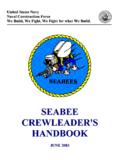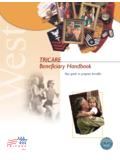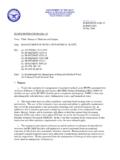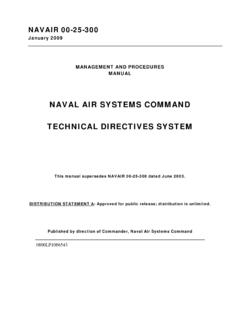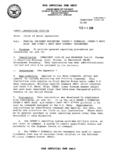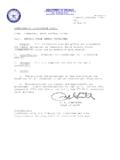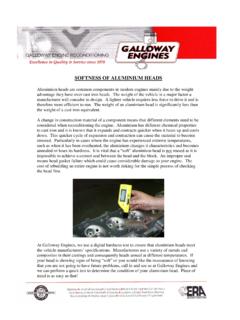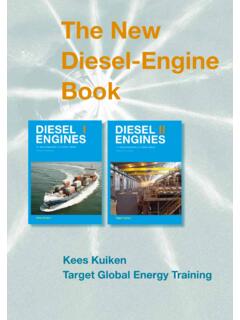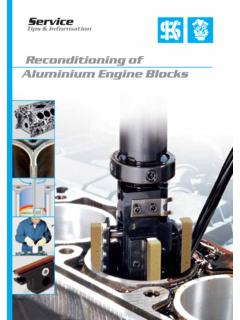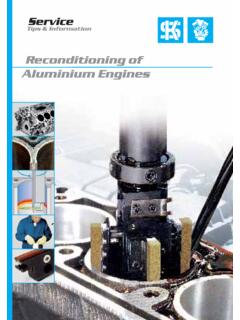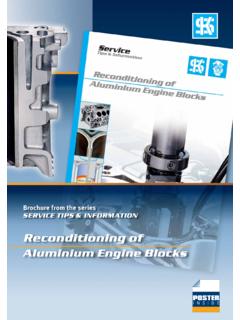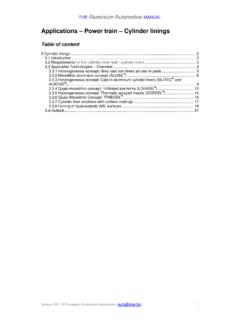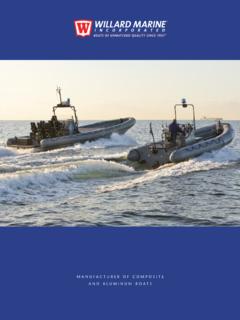Transcription of Chapter 3 Construction of an Internal Combustion Engine
1 Chapter 3. Construction of an Internal Combustion Engine Topics Engine Construction Engine Adjustment and Testing To hear audio, click on the box. Overview As a Construction Mechanic, you will benefit from knowledge about the Construction of an Internal Combustion Engine and its many moving and stationary parts, including the materials they are made of and their relationship to one another for the Engine 's smooth and efficient operation. The information provided in this Chapter will also help you both to diagnose malfunctions and to correct the problems. Since the gasoline and diesel engines used in today's Construction equipment are basically the same internally, the majority of information provided here applies to both.
2 Objectives When you have completed this Chapter , you will be able to do the following: 1. Identify the stationary and moving parts of an Internal Combustion Engine . 2. Identify the basic testing procedures used in constructing an Internal Combustion Engine . 3. Recognize operating principles and functions of stationary and moving parts within an Internal Combustion Engine . 4. Understand the techniques used in valve reconditioning. 5. Understand the techniques used in timing gear installation. 6. Understand the techniques used in adjusting Engine valves. 7. Recognize basic Engine testing procedures and required tools. Prerequisites None. NAVEDTRA 14264A 3-1.
3 This course map shows all of the chapters in Construction Mechanic Basic. The suggested training order begins at the bottom and proceeds up. Skill levels increase as you advance on the course map. Automotive Chassis and Body C. Brakes M. Construction Equipment Power Trains Drive Lines, Differentials, Drive Axles, and Power Train Accessories Automotive Clutches, Transmissions, and Transaxles Hydraulic and Pneumatic Systems Automotive Electrical Circuits and B. Wiring A. Basic Automotive Electricity S. Cooling and Lubrication Systems I. Diesel Fuel Systems C. Gasoline Fuel Systems Construction of an Internal Combustion Engine Principles of an Internal Combustion Engine Technical Administration Features of this Manual This manual has several features which make it easy to use online.
4 Figure and table numbers in the text are italicized. The figure or table is either next to or below the text that refers to it. The first time a glossary term appears in the text, it is bold and italicized. When your cursor crosses over that word or phrase, a popup box displays with the appropriate definition. Audio and video clips are included in the text, with italicized instructions telling you where to click to activate it. Review questions that apply to a section are listed under the Test Your Knowledge banner at the end of the section. Select the answer you choose. If the answer is correct, you will be taken to the next section heading. If the answer is incorrect, you will be taken to the area in the Chapter where the information is for NAVEDTRA 14264A 3-2.
5 Review. When you have completed your review, select anywhere in that area to return to the review question. Try to answer the question again. Review questions are included at the end of this Chapter . Select the answer you choose. If the answer is correct, you will be taken to the next question. If the answer is incorrect, you will be taken to the area in the Chapter where the information is for review. When you have completed your review, select anywhere in that area to return to the review question. Try to answer the question again. NAVEDTRA 14264A 3-3. Engine Construction . The Construction of an Engine varies little, regardless of size and design. The intended use of the Engine determines its size and design, and the temperature at which the Engine will operate determines the type of metal it will be built from.
6 To simplify the service parts and servicing procedures in the field, the current trend in Engine Construction and design is toward Engine families. Typically, there are several types of engines because of the many jobs to be done; however, the service and service parts problem are simplified by designing engines so they are closely related in cylinder size, valve arrangement, and so forth. For example, the GM series 71 engines can be obtained in two-, three-, four-, and six-cylinder in-line models. GM V-type engines come in 6-, 8-, 12-, and 16-cylinder models. These engines are designed in such a way that many of the Internal parts can be used on any of the models.
7 Stationary Parts of and Engine The stationary parts of an Engine include the cylinder block and cylinders, the cylinder head or heads, and the exhaust and intake manifolds. These parts furnish the framework of the Engine . All movable parts are attached to or fitted into this framework. Engine Cylinder Block The cylinder block is the basic frame of a liquid-cooled Engine whether it is in-line, horizontally opposed, or V-type. The cylinder block is a solid casting made of cast iron or aluminum that contains the crankcase, the cylinders, the coolant passages, the lubricating passages, and, in the case of flathead engines, the valves seats, the ports, and the guides.
8 The cylinder block is a one-piece casting usually made of an iron alloy that contains nickel and molybdenum. This is the best overall material for cylinder blocks. It provides excellent wearing qualities and low material and production cost, and it changes dimensions only minimally when heated. Another material used for cylinder blocks, although not extensively, is aluminum. Aluminum is used whenever weight is a consideration. However, it is NOT practical to use for the following reasons: Aluminum is more expensive than cast iron. Aluminum is not as strong as cast iron. Because of its softness, it cannot be used on any surface of the block that is subject to wear.
9 This necessitates the pressing, or casting, of steel sleeves into the cylinder bores. Threaded holes must also be deeper. This introduces extra design considerations and increases production costs. Aluminum has a much higher expansion rate than iron when heated. This creates problems with maintaining tolerances. Cylinder The cylinders are bored right into the block. A good cylinder must be round, not varying in diameter by more than approximately inch ( mm). The diameter of the cylinder must be uniform throughout its entire length. During normal Engine operation, cylinder walls wear out-of-round, or they may become cracked and scored if not lubricated or cooled properly.
10 The cylinders on an air-cooled Engine are separate from the crankcase. They are made of forged steel. This material is most suitable for cylinders because of its excellent wearing qualities and its ability to withstand the high temperatures that air-cooled cylinders obtain. The cylinders have rows of deep fins cast NAVEDTRA 14264A 3-4. into them to dissipate Engine heat. The cylinders are commonly mounted by securing the cylinder head to the crankcase with long studs and sandwiching the cylinders between the two. Another way of mounting the cylinders is to bolt them to the crankcase, and then secure the heads to the cylinders. Cylinder Sleeve Cylinder sleeves, or liners, are metal pipe- shaped inserts that fit into the cylinder block.
